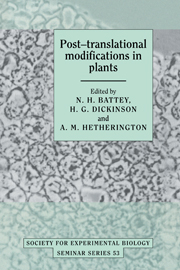Book contents
- Frontmatter
- Contents
- List of contributors
- List of abbreviations
- Preface
- Some roles of post-translational modifications in plants
- Signal transduction and protein phosphorylation in bacteria
- Roles of protein phosphorylation in animal cells
- The significance of post-translational modification of proteins by phosphorylation in the regulation of plant development and metabolism
- Post-translational modification of chloroplast proteins and the regulation of protein turnover
- Purification of a small phosphoprotein from chloroplasts and characterisation of its phosphoryl group
- Use of synthetic peptides to study G proteins and protein kinases within plant cells
- Activation of membrane-associated protein kinase by lipids, its substrates, and its function in signal transduction
- Distribution and function of Ca2+-dependent, calmodulin-independent protein kinases
- Phosphorylation of the plasma membrane proton pump
- The regulation of phosphoenolpyruvate carboxylase by reversible phosphorylation
- Protein phosphorylation and circadian rhythms
- Control of translation by phosphorylation of mRNP proteins in Fucus and Xenopus
- Regulation of plant metabolism by reversible protein (serine/threonine) phosphorylation
- Detection, biosynthesis and some functions of glycans N-linked to plant secreted proteins
- Biosynthesis, intracellular transport and processing of ricin
- Post-translational processing of concanavalin A
- The role of cell surface glycoproteins in differentiation and morphogenesis
- Ubiquitination of proteins during floral development and senescence
- Index
Signal transduction and protein phosphorylation in bacteria
Published online by Cambridge University Press: 06 July 2010
- Frontmatter
- Contents
- List of contributors
- List of abbreviations
- Preface
- Some roles of post-translational modifications in plants
- Signal transduction and protein phosphorylation in bacteria
- Roles of protein phosphorylation in animal cells
- The significance of post-translational modification of proteins by phosphorylation in the regulation of plant development and metabolism
- Post-translational modification of chloroplast proteins and the regulation of protein turnover
- Purification of a small phosphoprotein from chloroplasts and characterisation of its phosphoryl group
- Use of synthetic peptides to study G proteins and protein kinases within plant cells
- Activation of membrane-associated protein kinase by lipids, its substrates, and its function in signal transduction
- Distribution and function of Ca2+-dependent, calmodulin-independent protein kinases
- Phosphorylation of the plasma membrane proton pump
- The regulation of phosphoenolpyruvate carboxylase by reversible phosphorylation
- Protein phosphorylation and circadian rhythms
- Control of translation by phosphorylation of mRNP proteins in Fucus and Xenopus
- Regulation of plant metabolism by reversible protein (serine/threonine) phosphorylation
- Detection, biosynthesis and some functions of glycans N-linked to plant secreted proteins
- Biosynthesis, intracellular transport and processing of ricin
- Post-translational processing of concanavalin A
- The role of cell surface glycoproteins in differentiation and morphogenesis
- Ubiquitination of proteins during floral development and senescence
- Index
Summary
Introduction
Prior to 1986 it was assumed that protein phosphorylation played a relatively minor role in controlling the response of prokaryotes to environmental stimuli. Although many phosphoproteins had been detected by gel electrophoresis and a number of protein kinases had been purified, the physiological relevance of phosphorylation was not evident (Cozzone, 1984). The discovery of a role for phosphorylation in the response of bacteria to nitrogen status provided the first example of a defined stimulus–response pathway in which protein activity is controlled reversibly by phosphorylation and dephosphorylation (Ninfa & Magasanik, 1986). In the nitrogen regulation system two protein components are involved; one protein is a ‘sensor’ which has protein kinase activity and the other protein is a ‘regulator’ whose activity is responsive to phosphorylation. This pattern of ‘two-component regulation’ is surprisingly well conserved and serves to regulate a range of diverse processes in prokaryotes.
Bacteria are responsive to a wide variety of environmental signals including changes in nutrient concentration, osmolarity, temperature and the presence of other organisms. When DNA sequences of several genes involved in different signal transduction pathways were determined, it became obvious that many examples were representative of two families of proteins sharing amino acid similarities in common with the ‘sensor’ and ‘regulator’ proteins identified in the nitrogen regulation system (Nixon, Ronson & Ausubel, 1986; Winans et al., 1986; Ronson, Nixon & Ausubel, 1987b; Drummond & Wootton, 1987).
- Type
- Chapter
- Information
- Post-translational Modifications in Plants , pp. 17 - 38Publisher: Cambridge University PressPrint publication year: 1993



